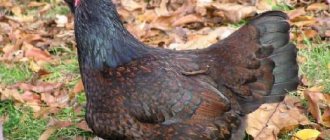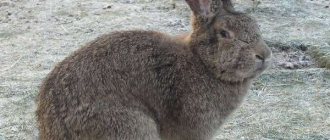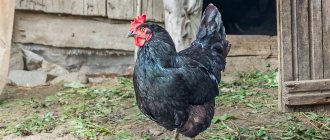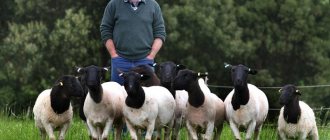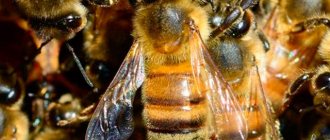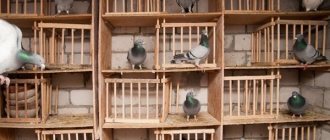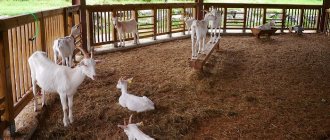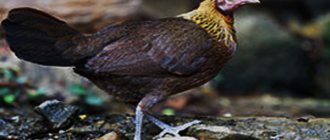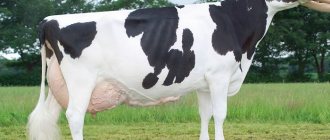Historical information about the breed
The Mechelen cuckoo is one of the most ancient breeds of poultry. Homeland - Belgium. The name sounds different in different languages, so the Mechelen cuckoo has a number of different names, one of the most popular is Malin. On the territory of the Russian Federation until 1917 it was famous by the name Cuco de Malin.
There is no reliable information about the creation of this breed; it is only known that it was bred around the 19th century. The ancestors are considered to be Brahma, Shanghai, Flemish and Chinese chickens. In Belgium they are proud of their birds; Malinov meat is considered a very expensive and tasty delicacy.
History of origin
The Mechelen cuckoo was developed in the 19th century. The bird was bred in the Mechelen region (Belgium). Poultry got its name from its place of origin. It acquired the second part of its name “cuckoo” due to its most common color. Most representatives of this breed are cuckoo-colored.
To obtain the breed, scientists had to cross local Belgian chickens with Oriental fighting breeds.
It came to Russia even before the October Revolution. However, the wars led to the fact that the popularity of the rather capricious meat bird dropped to almost zero.
Today, the popularity of Mechelenskaya is gradually recovering.
Exterior of a bird
The Mechelen cuckoo is a meat bird. The weight of the male is 5 kg, the female is 4.5 kg. At the beginning of the 20th century, this breed was again bred in its homeland, but its appearance changed slightly. The first option is characterized by a leaf-shaped comb.
At the beginning of the 20th century, the German army needed high-quality food, so breeders decided to cross Malin with one of the Belgian fighting breeds. Males are much larger than Mechen cuckoos. The watchmen gave the Malins a real triple comb.
Today, there are quite a few descendants of Mechen cuckoos and Bruges Wächter and the single leaf-shaped comb is considered the standard. Many works by breeders prove that experiments are still underway to improve this breed. Scientists have set a goal to create a Malin that at 10 weeks will weigh approximately 4 kg of live weight.
In terms of weight characteristics, Mehen cuckoos are similar to broilers, but they are better than them in the following ways:
- absence of genetic diseases that lead to the death of birds;
- during breeding, the chicks retain their “parental” characteristics;
- there are no difficulties in working with the heart;
- savings in feed.
Some bird historians argue that they were called Cuckoos not because of such plumage, but because of the lack of incubation instinct.
Standard
They are strong birds with strong legs. Due to their enormous body mass, they are not very agile and cannot fly.
Signs of the Malin chicken breed:
- small head;
- leaf-shaped comb;
- orange or red eyes;
- the earlobes and earrings are red, rather large, slightly elongated;
- small light beak;
- the neck is long and strong, vertical to the body;
- the mane of males is practically undeveloped;
- the back is smooth and massive;
- the braids on the tail are poorly developed;
- the tail itself is not bushy;
- the wings are small, the shoulder girdle of laying hens is strong, the wings are pressed to the body, they are almost invisible behind the feathers;
- wide muscular chest;
- the belly is slightly convex and developed;
- paws are strong; the thighs and legs are muscular;
- the metatarsals are white-pink, but can also be dark gray, feathered only on one side;
- the plumage is dense, most often variegated coloring is found.
Watch a video about what Mechelen cuckoo chickens look like:
Breed colors:
- Cuckoo.
- Black.
- Hawkish.
- White.
- Lavender.
- Colombian.
- Silver.
- Golden.
Vices
Despite the fact that the breed is very rare in the Russian Federation, some signs still classify the birds as non-purebred birds:
- undeveloped small breasts;
- white lobes;
- not wide back;
- body in the form of a triangle.
Defects also include a very light shade of feathers, but in fact, some colors are light in themselves.
In Belgium they were able to breed dwarf Mechelen cuckoos, but it is even difficult to find photographs of them because they are rare.
general characteristics
This breed has typical features like other representatives of meat breeds of chickens. Her body is quite dense and fleshy, but this does not affect her grace.
Since Mechelen cuckoos were created for breeding in free-range conditions, their large body does not in any way affect their vital activity, due to which the characteristic taste of Malin chicken meat is rich.
Appearance and standard
The Mechelen cuckoo breed has the following characteristic features:
| Part of the body | Description |
| Head | Medium size. |
| Crest | Leaf-shaped, small, simple structure, with 4-6 teeth of a rich red hue. Its rear edge is always located strictly horizontal to the body. |
| Beak | Strong, curved down, medium length. |
| Neck | Medium length, dense and powerful. |
| Breast | Wide, round and dense, protruding outward. |
| Stomach | Round, fleshy, but not pronounced. |
| Wings | Small, often shortened, tightly pressed to the body. Always located parallel to the body. |
| Tail | Short, set at an angle of 40-45° to the body. |
| Paws | Powerful, dense and meaty. Their inner side is covered with dense plumage. |
| Plumage and color | Well developed, under the dense main feather there is a fairly dense layer of down. The color of the plumage acquires a striped or speckled pattern. The most common colors used are white and black. Sometimes hybrids with white, blue, silver or Colombian colors can be found. |
Important! Individuals with long legs, a flat chest and excessively light body color, without a distinct ornament, are subject to mandatory selective culling.
Temperament
This chicken is attractive not only for its productivity and bright appearance, but also for its character. Representatives of the breed are distinguished by their affectionate, peaceful and calm behavior. They are not characterized by fuss and excessive noise, so keeping even a few dozen individuals in a household will not cause additional trouble.
The rooster in the chicken coop maintains a strict hierarchy and order, so the females are always well-fed and calm about their safety. When attacked by rodents or small predators, he can resolutely stand up for the herd, but his aggression towards humans does not manifest itself in any way.
Did you know? The Mechelen cuckoo got its unique “shaggy legs” by crossing the first hybrids with hawksbills. After crossing, the trait became so stable that subsequent matings with other breeds did not in any way affect its presence in the genotype.
Advantages and disadvantages
- The main positive qualities of Malin chickens:
- large and fleshy body;
- excellent taste and nutritional characteristics of meat;
- rapid weight gain;
- high resistance to various infections and sudden changes in weather conditions;
- unpretentiousness to living conditions;
- unique and aesthetic appearance.
- The negative aspects of the breed include:
- high gluttony;
- whimsicality to the diet and quality of feed;
- undeveloped brooding instinct;
- low egg production.
Characteristic features of the Mechelen cuckoo
This breed of chicken produces a huge amount of meat, but does not have high egg production. Birds are very friendly, they will not cause you much trouble and will not waste your time.
Character
Individuals are very peaceful, they do not fight or compete with each other. Males sometimes get into squabbles with other roosters, but this happens extremely rarely. Birds are famous for their high level of calmness and peacefulness; they walk without much activity, so you shouldn’t worry about the chickens running away from the walking yard.
Puberty and performance
Representatives of the Malin breed begin laying eggs only at 7 months, but they reach puberty much later - at 1 year. If the nutrition and maintenance were of poor quality, then maturation occurs later.
Eggs of one-year-old birds are collected and placed in an incubator, egg hatchability is 95%, and chicken survival rate is 97%.
Despite the meat direction, Mechelen cuckoos can boast of good egg laying. In a year, 1 female brings 150 eggs, each weighing more than 60 g. The shell is light pink.
Productivity
Malin poultry meat is tasty and juicy. It has a fine structure; in European countries the product is served in the most expensive restaurants. Males soon gain weight, and at the age of 4 months the carcass weighs approximately 2.2 kg. At 4 months – 3 kg.
Based on reviews from poultry farmers, it can be argued that at the age of 9 months a rooster weighs about 6 kg, but this is if it was raised for fattening and not for breeding.
Maternal instinct
Almost all hybrids have lost their brooding instinct during breeding, and this breed is no exception. A beginner breeding these birds may not cope with the task.
The first reason is that when crossing an incorrectly selected pair, you can end up with a large number of unfertilized eggs.
The second reason is the almost completely lost maternal instinct. Some hens happily sit on their offspring, then their mood changes and the hens leave. They can do whatever they want, just not sit on the nest. Therefore, there is no need to take risks and entrust such an important task to mother cuckoos.
Productivity
Characteristic:
- Egg production is approximately 150 eggs per year. I
- Egg – weighs 60-65 g.
- Puberty - chickens begin to lay eggs at 6 months.
- Weight - roosters grow from 4 to 5 kg, and hens weigh 3.5-4 kg when mature.
- Survival Rate – Approximately 95% of chicks survive.
Representatives of the Malin breed begin laying eggs only at 7 months, but they reach puberty much later - at 1 year. If the nutrition and maintenance were of poor quality, then maturation occurs later.
Eggs of one-year-old birds are collected and placed in an incubator, egg hatchability is 95%, and chicken survival rate is 97%.
Malin poultry meat is tasty and juicy. It has a fine structure; in European countries the product is served in the most expensive restaurants.
Advantages and disadvantages
The Malin breed of chickens, just like other poultry, has a number of pros and cons; they must be taken into account when breeding individuals.
Advantages:
- high productivity;
- beautiful appearance;
- large size birds;
- calm disposition;
- low maintenance requirements;
- rapid weight gain.
Flaws:
- difficulty in breeding;
- almost lost maternal instinct;
- rare distribution in the Russian Federation.
Advantages and disadvantages of the breed
Among the advantages of the breed are:
- meat – the carcasses of the breed are quite large and each one produces a lot of meat with excellent taste;
- character - chickens are calm, get along well with other breeds and types of birds;
- unpretentiousness - Mechelen cuckoos are not picky about their living conditions, they feel great even when conditions change;
- strong immunity - birds of this breed are resistant to diseases and tolerate them well;
- eggs – the breed’s egg production is average, but the size of the Malinov egg is quite large, averaging 65 g;
Rooster and hen Malin
But the breed also has disadvantages - the lack of maternal instinct. Malin chickens do not hatch eggs, so breeding is only possible in an incubator or with the help of chickens of other breeds.
Video - Brief overview of Malin chickens
How to care for the breed?
Hens need certain conditions, but in fact there is nothing complicated about it, you just need to build a chicken coop taking into account their size and needs.
Poultry house equipment
The main requirement is to build a large chicken coop. Birds are kept in cages extremely rarely, and this is only done in poultry farms. Also, when raising birds behind nets, they should be taught such a life from birth.
If you are equipping a poultry house only for Malins, then you should not place perches in it, because the large mass of individuals does not give them the opportunity to fly on them. These birds are kept only on the floor.
This feature of keeping Mechelen chickens forces the poultry farmer to carefully select bedding for the chicken coop. It will have to be changed much more often than other breeds. It's better to do this every week. Peat, straw, and hay are suitable materials. Make the layer dense, build the nests slightly higher than the floor so that individuals can easily climb into them without being damaged. Read about how to make nests for chickens with your own hands here.
Pay special attention to containers for food and water. Pour clean and fresh water into the drinking bowls every day; do not leave leftover feed in food containers, otherwise they will spoil.
Walk
Despite the lack of movement and tranquility, representatives love to walk in the fresh air. Walking helps build more muscle mass and makes the meat much tastier. You need to think about walks and build a large, comfortable yard.
The area is fenced with a net so that birds cannot escape. The height of the chain-link may not exceed 1.2 m, because due to the small and tightly fitting wings, individuals do not fly. If you are not afraid to let the birds roam freely, then you can do it. Chickens do not run away, they are also not particularly curious, so they will not climb into places they shouldn’t, chickens will not damage your crops and green spaces.
In Belgium, poultry farmers allow their birds to roam unattended without fear.
Diet
Mechelen cuckoos are not picky about their diet; it is prepared based on the needs of meat birds. 1 individual needs 150 g of food per day. Feed three times a day.
The basis of the menu is protein foods. If you purchase ready-made feed mixtures, then opt for broiler feed. Don't forget about mineral components and vitamins. You can feed laying hens wet mash.
Add fresh greens to your diet. In summer, birds will find such vitamins on their own, but in winter they cannot do without them. Do not give chickens cooked meat; only raw offal is suitable, otherwise they will develop stomach problems.
Light and thermal conditions, humidity
Meat chickens are not demanding on lighting, since a large amount of light affects egg production, and not the quality of meat. For raspberries, 10-12 hours of lighting per day is sufficient. However, this rule only works if the birds are kept separately from other breeds of chickens.
The temperature in the chicken coop should not fall below +12...+14 degrees Celsius. With this indicator, individuals feel quite comfortable. The minimum indicator that birds can withstand is +5 degrees, but this should not be allowed, otherwise egg laying will stop altogether.
Chicken droppings contain a small proportion of ammonia; it harms not only the respiratory system, but also the gastrointestinal tract of birds. To prevent this, regularly ventilate the room and remove the droppings.
The condition of birds is negatively affected by drafts and excess humidity, which can cause the development of many bacteria.
Molting and break in egg production
Seasonal molting is a standard phenomenon; during this period, birds suffer from a lack of vitamins. In some cases, attacks of cannibalism may occur, that is, birds begin to peck other individuals, and sometimes themselves. All these actions can be prevented with the help of a properly selected diet and an increased dose of vitamins.
Shedding season often begins in October or November and proceeds without difficulty. During this phenomenon, laying hens stop producing eggs, then the process is restored.
Review
Malin is a breed of chicken for meat production. These birds received the second name “cuckoo” due to the speckled color of their plumage, the inheritance of hawk and cuckoo chickens. Externally, the bird looks impressive, which is why Cucu de Malin chickens are often grown as ornamental birds.
Description
The description of the Cucu de Malin breed should begin with a strong, dense, stocky build. The bird is heavy, clumsy, calm and phlegmatic. The horizontally located body is set on strong, densely feathered legs. Massiveness combined with original coloring gives Malin chickens visual appeal.
Malin chickens have the following appearance characteristics:
- Wide back, rounded belly and chest.
- Short wings that fit tightly to the body.
- Short, modest-sized tail.
- A small head, with a developed, leaf-shaped, fleshy crest of red color.
- The earrings are large, bright.
- The beak is small pinkish in color.
- The color of the feather is speckled and striped in black and white shades. There are individuals blue, black or white.
One of the interesting details of the appearance of the Mechelen cuckoo chicken breed is the feathering of the legs. The front of the lower part of the leg is covered with thick feathers, and the back part is completely naked.
By nature, chickens of this breed are reserved and friendly. Manifestations of aggression in roosters are rare; only in exceptional cases can they rush into a fight.
Productivity
Cuckoo chickens have record body weights.
- The rooster grows up to 5 kilograms;
- Chicken - up to 4-4.5 kilograms.
Among birds kept in ideal conditions, there are also heavier specimens.
The peculiarity of the carcass of Mechelen cuckoos is the minimum amount of fat despite the large body weight of the bird. The meat is tender and soft due to its fine-fiber structure.
In Belgium there is a national dish that is prepared exclusively from the meat of chickens of this breed - “Mechelse kukuk” (translated as “Malin chicken”). This delicacy is usually served with the famous Belgian beer.
The carcasses of young birds are the most valuable in terms of taste. Therefore, already at 8-10 months it is recommended to send the bird to slaughter. Continued maintenance of a large herd is not advisable. With age, the taste of meat becomes worse. Meat from old chickens is only suitable after deep and prolonged heat treatment.
Unlike some popular meat breeds, Malin chickens are good layers.
- One chicken a year lays 140-165 eggs weighing 60-65 grams.
- Puberty of cuckoo chickens occurs late: they begin to lay eggs mainly by 8 months.
- At the beginning of laying, the eggs are small, then gradually increase in size.
- Late egg production is not considered a disadvantage of the breed, since Malin is raised for meat, and eggs are a nice bonus.
Breeding
Small females and males can be distinguished already at the age of 1 day - roosters have a light spot on the back, but hens do not. It is better to cull weak and unhealthy chicks immediately, otherwise they will lay poorly in the future.
Chick care
The babies are born small - approximately 40-45 g. The bodies of the chicks are dressed in “fur coats” from the first days. The fluff can be black and white or gray. Raising babies is not so difficult, but caring for them is real work.
Features of feeding chickens:
- The main course is high-protein food. Due to a lack of protein in food, babies develop developmental defects.
- Feed your babies 6 times a day, then reduce the amount to 4 meals. In this situation, they need to be kept until full puberty, and after that three meals are enough.
- Half of the menu should consist of vegetables and herbs. Don’t forget about their diversity; for example, carrots and potatoes are considered the best vegetables. For herbs, give nettle, dandelion and clover.
- Chicks need vitamins and minerals, thanks to them they grow and develop faster. To get rid of defects in skeletal development, add shells or chalk to the menu.
Problems during cultivation
Mechelen cuckoos do not cause any particular problems when growing. They are not demanding on their diet and have strong immunity. Delays most often occur when certain rules and recommendations are ignored.
Caring for the chicks
Hatched Mechelen cuckoo chicks weigh no more than 50 g each. They are covered with gray or white-black fluff.
The sex can be determined when the chicks have fledged a little. Females have darker colored feathers and a white patch on the crown.
For the first few days, the chicks are kept in a cardboard box. You need to put a layer of paper on the bottom. It is then replaced with a bedding of straw. Chicks can also be placed in a special brooder with a lamp for lighting and heating.
Each box should contain no more than 30 individuals.
If Mechelen chickens are fed fully, then by the age of one month they weigh 500-700 g. By the 2nd month of life they reach 2 kg or more.
Young chickens can be combined with adult chickens only from 3 months. At the same age they are transferred to a general diet.
Diseases and pests
Thanks to the numerous works of breeders, the Mechelen cuckoo chicken breed has acquired strong immunity. But, unfortunately, it does not protect birds from parasites. As a preventive measure, install ash baths in the poultry house.
Rules for processing the poultry house and birds:
- do not allow excessive contamination of the poultry house;
- change floor mats on time;
- do not leave leftover food in the feeders;
- change the water regularly;
- provide good ventilation in the poultry house;
- vaccinate your chickens.
Diseases and their treatment
Most often, growing raspberries occurs without complications. The breed is unpretentious in keeping; moreover, the birds have excellent immunity.
Difficulties can arise if the general rules for rearing are not followed at all, and also if mechelins are kept with other chickens with diseases.
Prevention
To avoid infection of birds, it is best to take care of disease prevention.
This is not difficult to do, just follow simple rules:
- Keep the poultry house clean. Avoid heavy contamination. It is especially important for Mechelen cuckoos to change the flooring, since they spend all their time on it.
- Do not leave wet food, and immediately throw away uneaten food after feeding. Otherwise, bacteria will develop in the feed.
- Keep the water clean and replace it with fresh water regularly. To avoid infection, it is best to use nipple drinkers or cover the drinkers with netting. This way the birds will be able to drink, but will not be able to climb into it.
- Many diseases can be prevented by vaccination, so do not neglect vaccinations.
Reviews about the breed
★★★★★
Alexey, 46 years old, agronomist, Volgograd. Still, you should follow all recommendations for keeping birds.
At first I decided to grow them in cages. The birds were constantly suffering from vitamin deficiency, and the taste of the meat was not particularly pleasant. The birds need constant walking, and before slaughtering the cuckoos they should be fed a mixture of dry milk and buckwheat. Do not regret spending money on such food, then the meat will really be juicy and tasty. ★★★★★
Iva, 35 years old, manager, Aksai. I like these chickens for their lovely appearance, and they also have good productivity.
In appearance they resemble wild chickens. Several years ago I barely acquired these laying hens, and now I am breeding only their breed. Others are no longer interested. Hide
Add your review
Raising Belgian chickens of the Mechelen cuckoo breed is a profitable activity because they cause almost no problems and are considered low-maintenance birds.
0
0
Copy link
Content
English-language sources indicate that raspberries can even live in cages, but the best results will be obtained if the birds have a large range. Another problem with cage keeping and a cramped chicken coop is that the Mechelen cuckoo’s metatarsals are heavily feathered. The video shows that the feathers are long and touch the ground.
Keeping it on a dirty floor will cause droppings to stick to your feathers and fingers. Such lumps become very hard and the chicken cannot remove them on its own. If you miss the moment and the lump of droppings remains on the paw for a long time, it can lead to tissue necrosis.
The perches for these birds are kept low, but it must be remembered that their advertised inability to fly is conditional. The fence for these chickens should be more than a meter high.
